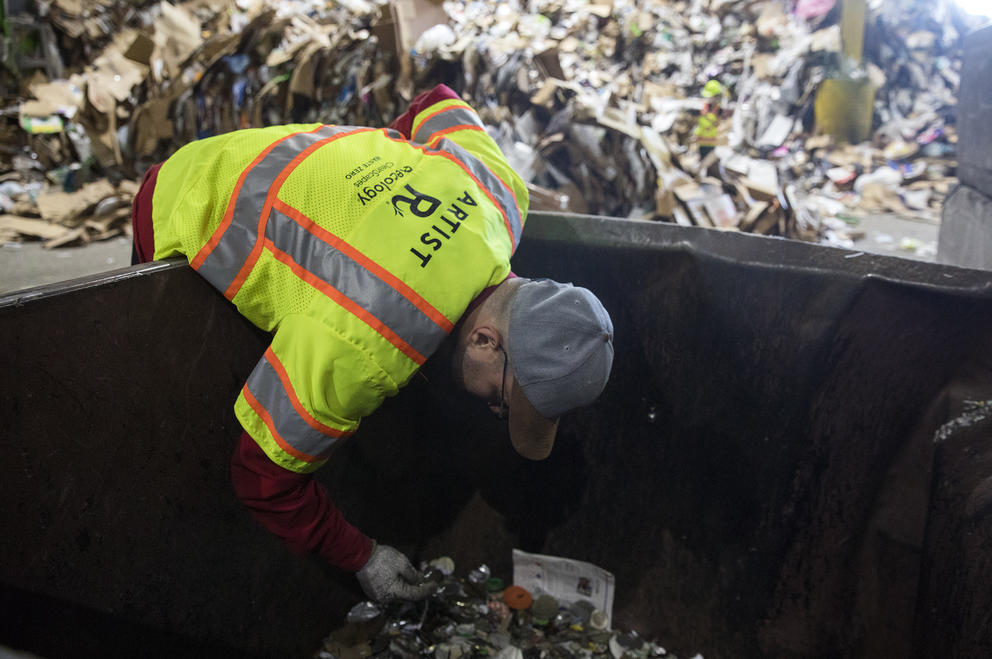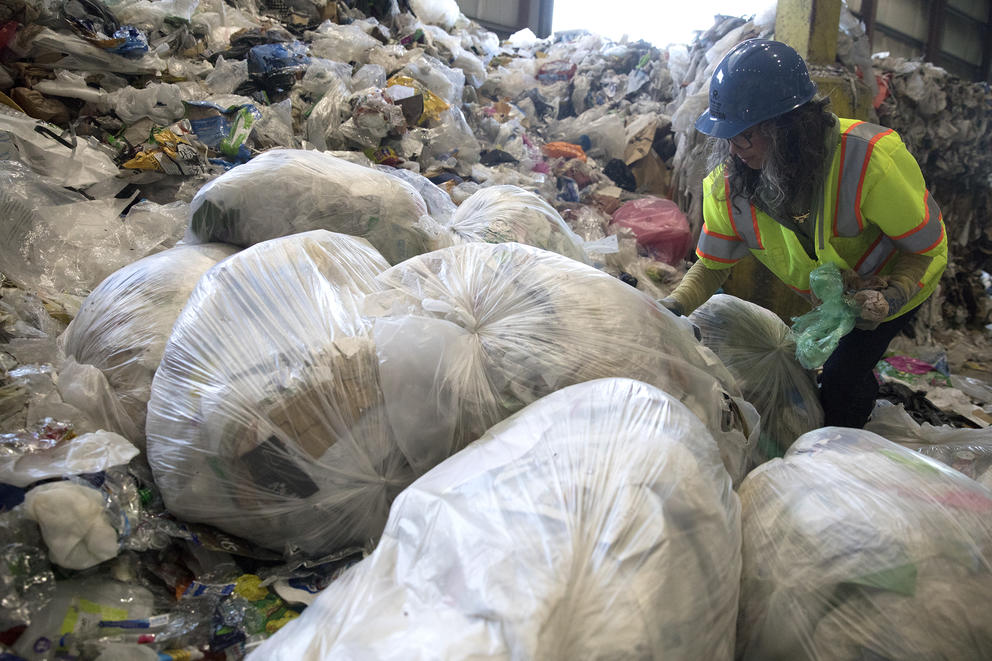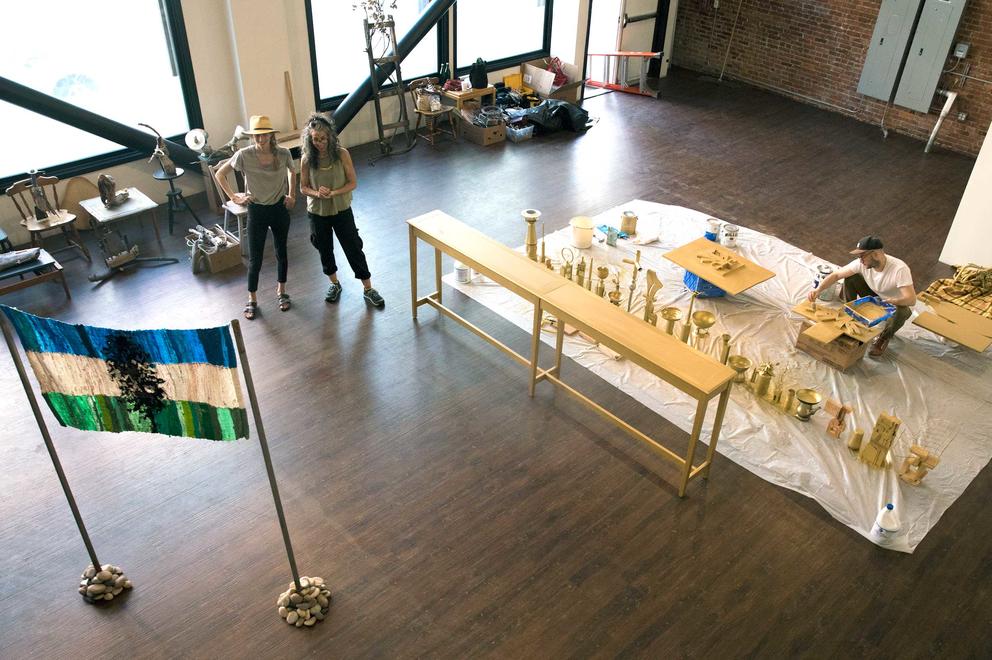A mountain of unsorted recycling material rises nearly two stories against a back wall, and grows higher each time the company’s white recycling trucks roll in and dump their loads onto the concrete floor. Elsewhere in the facility, workers and machines sort and compress materials, placing the bales into freestanding stacks, just like the movie’s titular trash-compacting robot.
But this isn’t science fiction, it’s a window into our waste-filled environmental reality. And it’s also the site of an innovative artist residency.
“This place is crazy. I love it,” says Maria Phillips, who runs the artist in residence program at Recology. Before taking on the management role, she was a 2018 artist in residence here, making large installations out of hundreds of “single-use” cups that hold our daily lattes. Now she’s wearing a T-shirt that reads, “Make Art, Not Landfill,” and giving an enthusiastic overview of the Material Recovery Facility, which she calls “Murph,” like a good buddy.
Phillips stands in a conference room overlooking the conveyor belts, forklifts and tall garage doors left open to accommodate the stream of trucks. She gesticulates while describing the many-step recycling process, how materials travel from the pile on the floor to the gigantic green sorting machine with zigzagging conveyor belts, before arriving at the baler. After that, the bales of bundled paper, plastic bottles, even broken down recycling bins sit in stacks, awaiting purchase and pickup by whomever can provide a new, recycled life.
“Aren’t those bales beautiful?” Phillips says, as the paper edges flutter in the breeze.
The creative possibilities in all this raw material are thrilling for an artist. And it’s all up for grabs as part of the residency.
Now in its fifth year at the Seattle site, the artist in residence program is based on a Recology initiative that started in San Francisco in 1990. Since then, residency programs have popped up at Recology recycling facilities in Portland and Astoria, Oregon. Here in Seattle, two artists receive full access to materials that come into the MRF over a five-month stint (April to August). At the end of the residency, Recology produces a gallery show of work the artists have made using only materials gathered at the facility. (Sept. 5, 6 to 9 p.m. at 109 S. Washington St. in Pioneer Square.)
Just as WALL-E surfs the garbage heaps for treasures to take home — a bobblehead dog toy, a golden trophy, a hinged ring box — artists in residence roam the space with an eye out for intriguing items — a toy gun, a set of new knives, the detritus from an entire bachelorette party.
“You could become a hoarder in five minutes here,” says Hernan Paganini, one of the current resident artists. “There’s just so much stuff with potential.”
Originally from Argentina, Paganini has been in Seattle only for a year, but his previous work landed him a spot in the dump. For his long-running “Portrait of the World” series, Paganini has been collecting castoffs found in the streets of Argentina, Bolivia and Spain, and transforming them into collaged sculptures.
“Here it’s completely different — the scale is like nowhere else,” Paganini says of the facility. “You can see the capitalism. It’s overwhelming.”
Susan Robb, a longtime multimedia artist in Seattle, is the other artist in residence right now.
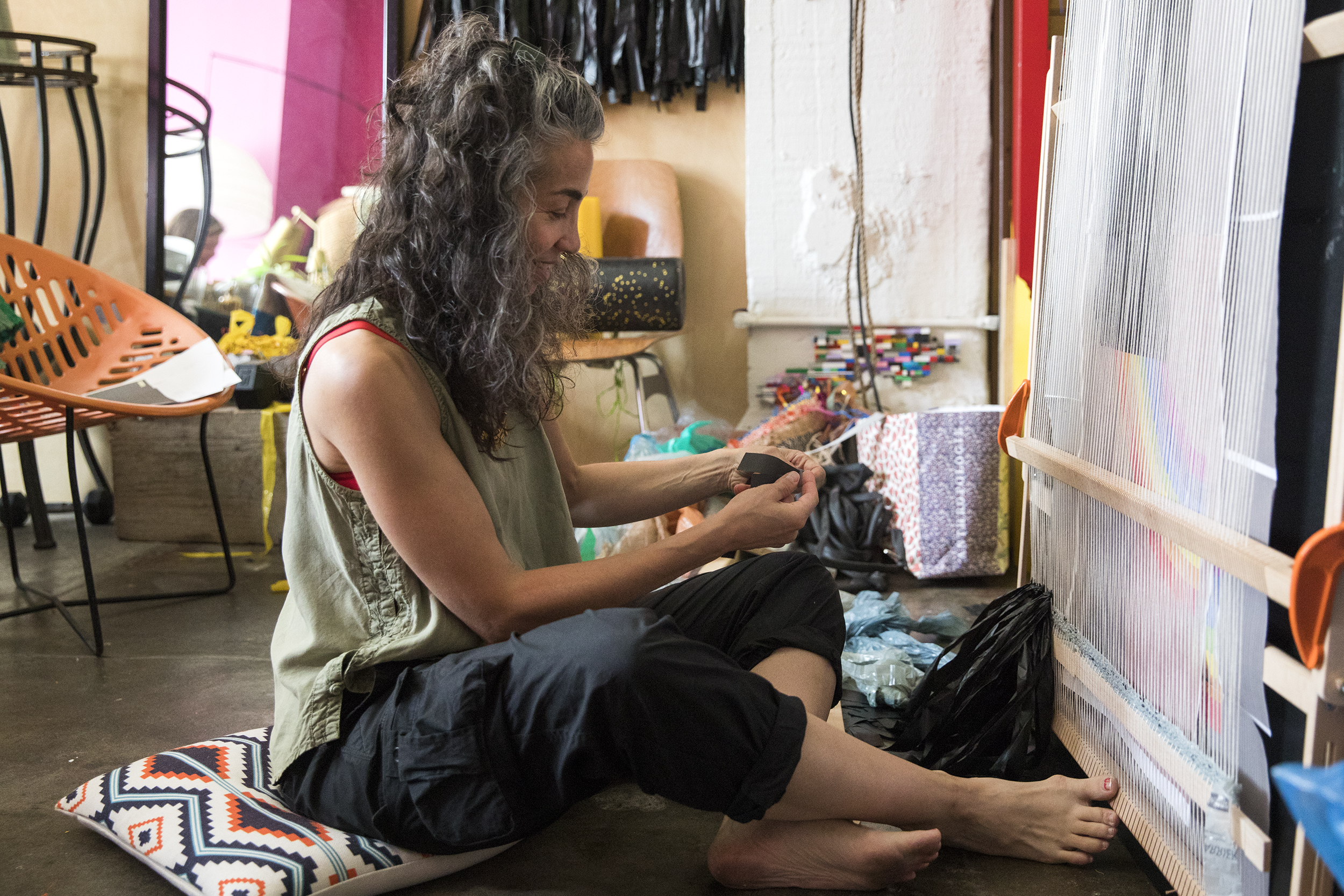
“My work is based on our emotional connection to place,” Robb says. In this case, the specific location of the Recology center, near the Duwamish River, came into play.
“I’m thinking about the site itself, and how Native people might have been using the land originally — foraging, gathering and picking the natural resources they found here, and making domestic objects, such as vessels and textiles,” says Robb. She’s creating such objects by forming shredded office paper into bowls, and weaving colorful plastic bags on a loom.
Robb has a particular fascination with shopping bags from trendy clothing store Forever 21.
“I’m obsessed with them,” she says of the yellow bags, which she’s collecting and weaving into cordage to create fishnets. “First of all, there’s a sort of Lolita thing implied — so it’s gross on that level. Plus, there’s the problem with ‘fast fashion.’ And then there’s scripture on the bottom of the bag.”
She flips one up to show the words John 3:16. “It’s the one that means something like, ‘if you believe in me, you will have eternal life,’ ” Robb says, cracking up. “I mean, it’s just so perfect for a plastic bag that will never get recycled!”
Phillips explains that this category of material is called “filmy” plastic.
“It’s the lowest of the low,” she says. “It’s at the very end of the recycling process. People haven’t figured out a way to recycle it into something useful, so it sits here.”
Decked out in yellow safety vests, hardhats and gloves, the artists fan out onto the floor. The sorting machine produces a tremendous amount of noise, as conveyor belts roll along, spinning wheels whiz and magnets yank ferrous metal off the line. Human workers make sure the machines aren’t jammed with improper materials, of which there are many, including basketballs, clothing, gas cans, garden tools, hypodermic needles and the occasional dead animal.
“Isn’t this awesome?!” shouts Phillips over the din.
It doesn’t smell great, but maybe better than expected. There is particulate suspended in the air and crushed glass on the floor. Crows fly in through the open warehouse doors to hunt for treasures alongside the artists, who wonder if the cat-sized rat they’ve seen will make an appearance today.
Phillips leads the group down a long, high-roofed hall lined with towering bales of blue-gray plastics. “This is such a gorgeous aisle,” she comments, appreciating the destination-less bales for their subtle shifts in color.
Robb spies a bit of bright blue plastic bag poking out from one corner. She grabs it with a gloved hand and tries to pull it out, but it’s stuck. She needs it for the green, white and blue Cascadia flag she’s weaving as part of her residency series. “We have this image of ourselves as this environmental bioregion,” she says. “Like, we recycle! But, uh …”
Paganini walks back across scatterings of crunchy glass to dig through the metal discard bin, where he has found many of the pieces he’s incorporating into what he calls “orphans,” hybrid sculptures that resemble trophies crafted by magpies. He describes one, made from a tin of peaches and an olive oil can, as resembling “King Arthur’s cup.” In another sculpture, he imparts a round hand-towel hook with a regal air by orienting it vertically atop a block of wood. Like Robb, he imbues his work with a dark sense of humor.
“I’m looking at superficial luxury,” Paganini says.
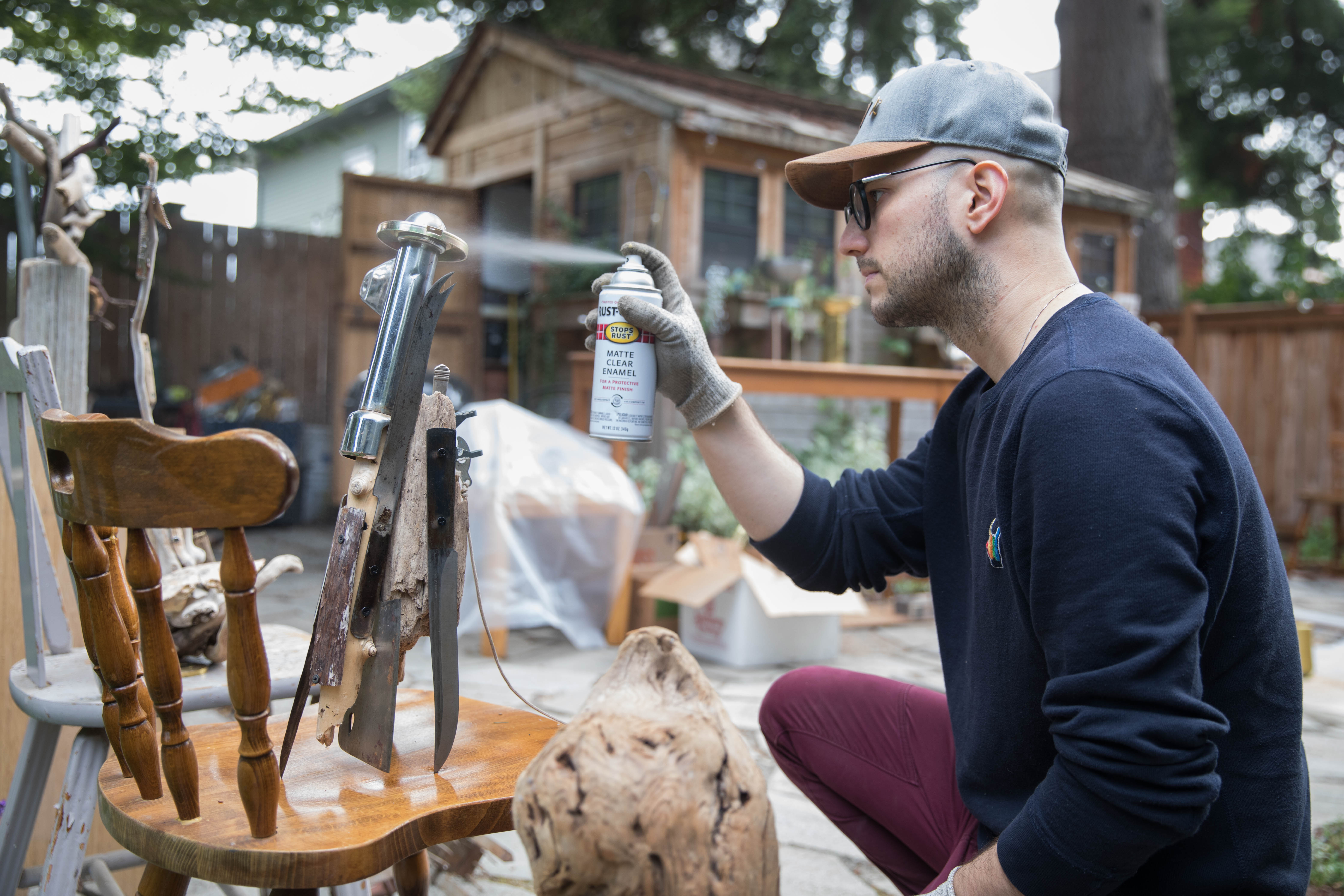
He builds his sculptures from found metal and wood, sometimes attaching the disparate parts with hinges, sometimes “sewing” them together with wire, allowing the pieces to be malleable — as if for a yet to be discovered purpose.
“I like to think about alchemy, how coal can become jewelry,” he says.
In one impressive piece, he strung together 251 found metal items, including a shovel head, grass edger blade, aluminum baseball bat and saw, into a wall-sized necklace, which he painted gold. His work takes on contemporary obsessions but also the history of colonial invaders, specifically those who landed in South America and, as Paganini puts it, “stole beautiful gold artifacts and melted them down to make coins.”
He says when he was going out on the floor to pick regularly, he found he needed to do a “small meditation” to ground himself.
“All the things here are the shadow of the population,” Paganini says, “the things people don’t want to see. It’s charged with a lot of unconscious information.”
Robb agrees, describing the new art objects she’s creating as “animated by shadow properties of their former lives.” Despite her four-step washing and bleaching system, she contends the items “can’t help but speak about the extravagance of convenience, the luxury of waste.”
A conveyor belt trundles by ferrying someone’s journal, a temporary driver’s license, a pile of bills. “There’s a lot of anxiety in these objects,” Robb says.
Phillips hopes the Recology art exhibits encourage visitors to think more deeply about the waste they create. “This stuff goes in our blue bin and supposedly ‘goes away,’ ” she says. “But people don’t see this part.” She wants more people to tour the facility, and recognize that just because something goes in the recycling bin doesn’t mean it disappears from Earth.
“It sits here until a buyer arrives — someone, somewhere who can reincorporate the trash into something else,” Phillips says. “But Malaysia, India and China are all saying no, they don’t want our recycling any more.”
She floats an idea: “Every teenager should have to work here for a time,” Phillips says. “I mean, kids do sustainability projects in school,” she continues, “but they’re not connecting what it really means to eat a bag of chips every day.” (Reminder: chip bags are not recyclable.)
As she speaks, another recycling truck pulls into the MRF and prepares to unload. Piles of cardboard shipping boxes pour out, many bearing a telltale smiling logo.
“All these things that get ordered in boxes, every day,” Paganini says. “Soon we’ll be covered by these mountains of recycling.”
As a bulldozer pushes the trash toward the back wall, Recology’s hopeful motto — “A world without waste” — seems less achievable. Maybe the stuff of science fiction.
L-R: Jayelle Paganini (Hernan's wife), Susan Robb and Hernan Paganini prepare to install their show of work created with material collected at the waste facility. The Recology Artist in Residence exhibit opens for First Thursday Art Walk, Sept. 5, 6-9 p.m. at 109 S Washington St. in Pioneer Square.
Get the latest in local arts and culture
This weekly newsletter brings arts news and cultural events straight to your inbox.




